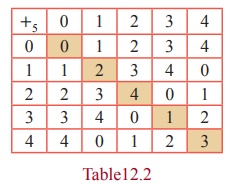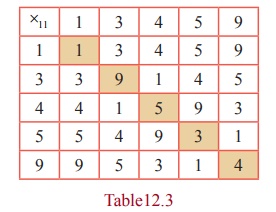Discrete Mathematics | Mathematics - Binary operations: Modular Arithmetic | 12th Maths : UNIT 12 : Discrete Mathematics
Chapter: 12th Maths : UNIT 12 : Discrete Mathematics
Binary operations: Modular Arithmetic
Modular Arithmetic
Having
discussed the properties of operations like basic usual arithmetic operations,
matrix addition and multiplication, join and meet of boolean matrices, one more
new operation called the Modular Arithmetic is
discussed in this section. The modular arithmetic refers to the process of dividing some number a by a positive
integer
n ( > 1), called modulus, and then equating a with the remainder b modulo n and it is written as a ≡ b(mod n) , read as ‘a is congruent to b modulo n ’
Here a ≡ b (mod n ) means a − b = n ⋅ k for some integer k and b is the least non-negative
integer when a is
divided by n.
For
instance, 25 ≡ 4(mod 7), −20 ≡ −2(mod 3) ≡ 1(mod
3) and 15
≡ 0(mod
5), etc. Further the set of integers when divided by n , leaves
the remainder 0, 1, 2, , n-1.
In the case of ℤ5,
[0] = { .. ., −15, −10, −5,
0, 5,10,15, … }
[1] = {… , −14, −9, −4,1,
6, 11, …}
[2] = {… , −13, −8, −3,
2, 7,12,…]
[3] = {…,
−12, −7, −2, 3,8,13,…}
[4] = {… , −11, −6, −1,
4, 9,14,…}.
We write
this as ℤ5 = {[0],[1],[ 2],[3],[ 4]}
. In each class, any two numbers are congruent modulo 5.
Before 2007, modular
arithmetic is used in 10-digit ISBN (International Standard Book Number) numbering system. For instance, the last digit is for parity
check. It is from the set {0,1, 2,3, 4,5, 6, 7,8,9, X } . In ISBN number, 81-7808-755-3, the last digit 3 is obtained as
1*8+2*1+3*7+4*8+5*0+6*8+7*7+8*5+9*5=8+2+21+32+0+48+49+40+45=245
≡
3(mod11).
Alternatively,
the weighted sum is calculated in the reverse manner
9*8+8*1+7*7+6*8+5*0+4*8+3*7+2*5+1*5=245
= 3
(mod 11).
In both
ways, we get the same check number 3.
After 2007, 13-digit
ISBN numbering has been followed. The first 12 digits (from left to right) are multiplied by the weights 3,1,3,1,…. starting from right to left.
Then the weighted sum is calculated.
The
higher multiple of 10 is taken. Then the difference is calculated. Then its
additive inverse modulo 10 is the thirteenth digit.
For
instance, consider the ISBN Number: 978-81-931995-6-5.Take 12 digits from left to
right.

The
total of last row is 155. The nearest (higher) integer in multiples of 10 is
160. The difference 160-155=5. The additive inverse modulo 10 is 5
which is 13-th digit in the ISBN number.
Two new
operations namely addition modulo n(
+n )
and multiplication
modulo n(×n )
are defined on the set ℤn of all non-negative integers less
than n under modulo arithmetic.
Definition 12.6
(i) The
addition modulo n is defined as
follows.
Let a,b
∈ ℤn . Then
a + nb = the remainder of a + b on division by n .
(ii) The
multiplication modulo n is defined as
follows.
Let a,b
∈ ℤn . Then
a × n b the
remainder of a ×b on division by n
Example 12.9
Verify (i)
closure property, (ii) commutative property, (iii) associative property, (iv) existence
of identity, and (v) existence of inverse for the operation +5 on ℤ5 using table corresponding to
addition modulo 5.
Solution
It is
known that ℤ5 = {[ 0 ], [1], [2], [3], [4]}
. The table corresponding to addition modulo 5 is as follows: We take reminders
{0,1, 2, 3, 4} to represent the classes {[0],[1],[2],[3],[4]} .

(i) Since
each box in the table is filled by exactly one element of ℤ5 , the output a +5 b
is unique and hence +5 is a binary operation.
(ii) The
entries are symmetrically
placed with respect to the main diagonal. So +5 has commutative property.
(iii) The
table cannot be used directly for the verification of the associative property.
So it is to be verified as usual.
For
instance, ( 2 + 5 3)
+5 4 = 0 +5 4 = 4 (mod 5)
and 2 +
5 ( 3 +5 4 ) = 2 +5 2 = 4( mod 5) .
Hence (
2 +5 3) + 5 4 =
2 +
5 ( 3 +5 4) .
Proceeding
like this one can verify this for all possible triples and ultimately it can be
shown that +5 is associative.
(iv) The
row headed by 0 and the column headed by 0 are identical. Hence the identity
element is 0.
(v) The
existence of inverse is guaranteed provided the identity 0 exists in each row
and each column. From Table12.2, it is clear that this property is true in this
case. The method of finding the inverse of any one of the elements of ℤ5 , say 2 is outlined below.
First
find the position of the identity element 0 in the III row headed by 2. Move
horizontally along the III row and after reaching 0, move vertically above 0 in
the IV column, because 0 is in the III row and IV column. The element reached
at the topmost position of IV column is 3. This element 3 is nothing but the
inverse of 2, because, 2 + 5 3 =
0 (mod 5) . In this way, the inverse of each and every element of ℤ5 can be obtained. Note that the
inverse of 0 is 0,that of 1 is 4, that of 2 is 3, that of 3 is 2 , and, that of
4 is 1.
Example 12.10
Verify (i)
closure property, (ii) commutative property, (iii) associative property, (iv) existence
of identity, and (v) existence of inverse for the operation ×11 on a subset A = {1, 3, 4, 5, 9} of the set of remainders {0,1, 2,3, 4,5, 6,
7,8,9,10}.
Solution
The
table for the operation ×11 is as follows.

Following
the same kind of procedure as explained in the previous example, a brief
outline of the process of verification of the properties of ×11 on A is given below.
(i) Since
each box has an unique element of A, ×11 is a binary operation on A.
(ii) The
entries are symmetrical about the main diagonal. Hence ×11 has commutative property.
(iii) As
usual, the associative
property can be seen to be true.
(iv) The
entries of both the row and column headed by the element 1 are identical. Hence
1 is the identity
element.
(v) Since
the identity 1 exists in each row and each column, the existence of inverse property is
assured for ×11 . The inverse of 1 is 1, that of 3
is 4, that of 4 is 3, 5 is 9 , and, that of 9 is 5.
Related Topics